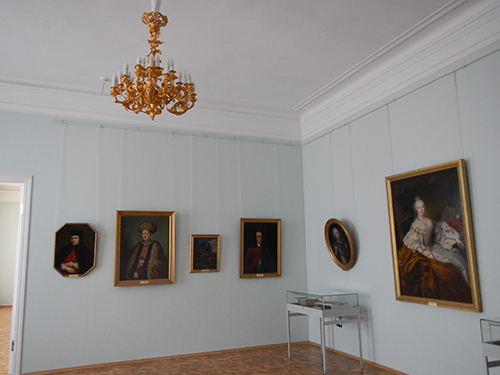Portrait painting of the first half of the 18th century

The European masters employed in Russia greatly influenced the national painting school. Representing a variety of schools such as French, Italian or German, they gave an impetus to the development of secular art and also provided training for Russian artists. The rapid development of secular portraiture began in the Petrine era.
The gallery displays some interesting pioneering works by Russian painters from the early 18th century - the portraits of tsarinas Natalia Kirillovna and Marfa Matveevna.
The European painters introduced the ceremonial portrait in Russia. One of the most renowned portrait painters was Georg Christoph Grooth. His work is best represented by the portraits of Empress Elizabeth and Grand Duke Petr Feodorovich.
Along with the ceremonial portrait, the intimate portrait emerged through which painters strove to capture the personalities and inner world of sitters. Such an example is the portrait of Grand Duchess Ekaterina Alexeevna, painted by the French artist Louis Caravaque in 1745 - a year after she had arrived in Russia. The sixteen-year-old German princess became the wife of Grand Duke Petr Feodorovich, the successor to Empress Elizaveta Petrovna. The portraits of officials and military leaders also date from the period of Elizabeth: I.I. Shuvalov, S.F. Apraksin, V.V. Fermor and Baron von Lieven, a commander of Oranienbaum troops of Grand Duke Petr Feodorovich.
See on interactive plan

The European masters employed in Russia greatly influenced the national painting school. Representing a variety of schools such as French, Italian or German, they gave an impetus to the development of secular art and also provided training for Russian artists. The rapid development of secular portraiture began in the Petrine era.
The gallery displays some interesting pioneering works by Russian painters from the early 18th century - the portraits of tsarinas Natalia Kirillovna and Marfa Matveevna.
The European painters introduced the ceremonial portrait in Russia. One of the most renowned portrait painters was Georg Christoph Grooth. His work is best represented by the portraits of Empress Elizabeth and Grand Duke Petr Feodorovich.
Along with the ceremonial portrait, the intimate portrait emerged through which painters strove to capture the personalities and inner world of sitters. Such an example is the portrait of Grand Duchess Ekaterina Alexeevna, painted by the French artist Louis Caravaque in 1745 - a year after she had arrived in Russia. The sixteen-year-old German princess became the wife of Grand Duke Petr Feodorovich, the successor to Empress Elizaveta Petrovna. The portraits of officials and military leaders also date from the period of Elizabeth: I.I. Shuvalov, S.F. Apraksin, V.V. Fermor and Baron von Lieven, a commander of Oranienbaum troops of Grand Duke Petr Feodorovich.
See on interactive plan
